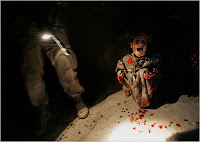
Zoriah Miller, the freelance photographer who took the image below and others of marines killed in a June 26 suicide attack and posted them on his Web site, was subsequently forbidden to work in Marine Corps-controlled areas of Iraq. Maj. Gen. John Kelly, the Marine Corps commander in Iraq, is now seeking to have Mr. Miller barred from all United States military facilities throughout the world. Mr. Miller has since left Iraq.

In November 2004, Stefan Zaklin, a photographer then working for the European Pressphoto Agency, was embedded with a United States Army company. Mr. Zaklin photographed this soldier, who was shot and killed in Falluja, in a house used as a base by insurgents. The photograph ran in several European publications, and Mr. Zaklin was immediately banned from working with the unit.

Two New York Times journalists were disembedded in January, 2007, after the newspaper published this photo of a mortally wounded soldier. Though the soldier was shot through the head and died hours after the photo was taken, Lt. Gen. Raymond T. Odierno argued that The Times had broken "embed" rules by not getting written permission from the soldier.

After Michael Kamber, on assignment for The New York Times, took photos of wounded American soldiers in Latifiya in 2007, he was told by military public affairs officers that the images could not be published. Though embed regulations prohibit only publishing photos of identifiable wounded soldiers without their permission, Lt. Col. Josslyn Aberle insisted in a phone conversation with Mr. Kamber that no photos could be published that showed faces of non-wounded soldiers. Later the same day she further tightened the rules, saying that any photos that showed division shoulder patches could not be used.


You are looking at the blood of a “gravely wounded soldier at the Ibn Sina Hospital” in the Green Zone 2007.
 Chris Hondros of Getty Images was with an army unit in Tal Afar on January 18, 2005, when its soldiers killed the parents of this blood-spattered girl at a checkpoint, and his photo was published around the world. Mr. Hondros was kicked out of the unit, though he soon became embedded with a unit in another city.
Chris Hondros of Getty Images was with an army unit in Tal Afar on January 18, 2005, when its soldiers killed the parents of this blood-spattered girl at a checkpoint, and his photo was published around the world. Mr. Hondros was kicked out of the unit, though he soon became embedded with a unit in another city.
2 comments:
In the link to the New York Times provided, there are representative photos from other wars in our past which demonstrate the degree to which this Iraq mess has been, as you say, 'sanitized'.
I added another photo, Doc.
Post a Comment